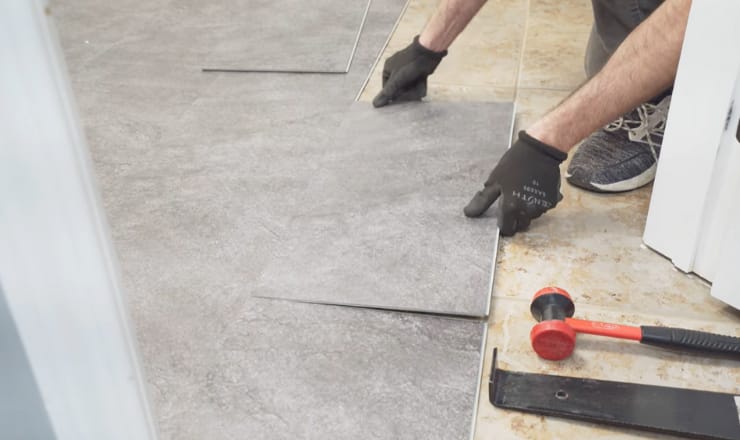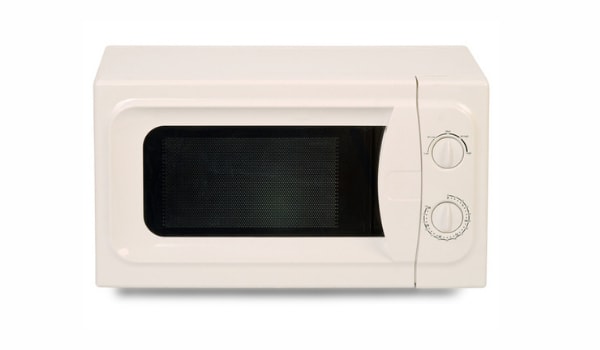There was a time when wooden flooring was popular and considered to be aesthetic. Then came ceramic tile flooring. Though ceramic tile floor is still equally popular, some homeowners consider changing it with vinyl flooring. But can you install vinyl flooring over ceramic tile?
You can install vinyl flooring over ceramic tile floors. Such flooring does not require any underlayment and is easy to install. However, you need to be careful with the ceramic tile joints and should fix any existing cracks. You also need to consider the height of the floor.

Vinyl flooring is the best way to change your home’s flooring appearance without spending a lot of money. But that does not mean it does not have any drawbacks.
Nevertheless, if you want to add vinyl flooring over the ceramic tiles, this article will help you get the job done. So feel free to read the entire article to learn more about vinyl flooring
Quick Navigation
What Type Of Vinyl Flooring Can You Put Over Ceramic Tile?
You have already learned about can you install vinyl flooring over ceramic tile. But what type of vinyl flooring is the best option for the job?
Vinyl flooring material comes in various thicknesses and installation options. But before you consider any other opinions, let’s check out the types of vinyl flooring you can install on ceramic tiles.
Glue-Stripe Planks
The glue-stripe vinyl planks are also known as peel-and-sticks. That is because you peel the vinyl stripes and stick them over the ceramic tile floor with the glue sticking to their backs.
These stripes are the most affordable vinyl flooring type of all. Besides, they are easy to install and are not time-consuming.
However, glue-stripe does not work if the ceramic floor underneath is not smooth and clean. And even if the stripes stick for a while somehow, they will become disastrous soon.
Waterproof Vinyl Planks
If you plan on changing the floor of areas that are likely to get wet frequently, the waterproof vinyl planks are the right choice. These planks are water-resistant and usually last a long time.
They are highly suitable for the bathroom and kitchen floor. Most other vinyl flooring types are not compatible with such areas like the waterproof one.
Luxury Vinyl Tiles
The luxury vinyl tiles (LVT) or the luxury vinyl planks (LVP), whatever you call it, is the most commonly available vinyl flooring system available in the market. While installing, you snap them together just like laminate planks.
These planks are also waterproof and come at an affordable price. The best thing about the luxury vinyl planks is that they come in beautiful colors and patterns, such as wood, stone, geometric patterns, etc.
Rigid-Core Vinyl Planks
The rigid-core vinyl planks are more suitable for commercial locations. And you can use the ceramic tile.
These are engineered vinyl flooring with multiple layers, making them last longer, even in high-traffic areas. And like the previous two types of vinyl flooring, this one is also water-resistant.
Pros Of Laying Vinyl Over Ceramic Tile
If you consider getting vinyl flooring over the existing ceramic tiles, know that it is not as odd as it sounds. This method allows you to give the floor an aesthetic look without costing you a fortune.
Moreover, they are durable and do not require much maintenance. Now, let’s look at a more detailed description of all the advantages you will get from vinyl flooring.
Vinyl Flooring Is Affordable
One of the many reasons vinyl flooring is the best option to transform your floor is because they are more affordable than any other material. Whether it is the price of the vinyl flooring or the installation cost, you will be able to save money.
Besides, these floorings are now commonly available, making them less expensive. They don’t cost much to maintain either.
Easy To Install
Vinyl planks are more like DIY flooring project items. If you are used to doing bits and pieces of home renovating things, you can install the flooring without hiring anyone and even without an assistant.
The glue-stripe vinyl flooring is the easiest and the most flexible option. All you need to do is take the peel off and glue the planks over the tiles. You do not need to see them or nail them to the floor. They do not need underlayment for installation.
Versatile And Aesthetic Appearance
You will be surprised to see how many different patterns and types of vinyl flooring you may come across in the marketplace. Each type contains a thin to a thick layer with various qualities. And then there are the patterns and designs.
Some vinyl planks come with wooden patterns that look like you have a beautifully varnished wooden floor. There is also stone-like vinyl that adds a modern touch to your home. You can also get grout-like vinyl flooring that appears like ceramic counterparts.
They Are Durable
Vinyl planks are not heavy, thick, or expensive like ceramic tiles. However, these flooring materials last longer without tearing or cracking if you maintain them properly.
If you think some floor areas will go through more or heavier traffic, you can put carpet or mat on them. It will protect the flooring planks from possible damages.
Low Maintenance
The vinyl floorings require less maintenance than other types of flooring. The surface type is pretty easy to clean using only a wet mop. You can also deep clean them occasionally using a homemade solution, such as a mixture of vinegar and water.
But it would be best if you did not clean the floor with scrubs, detergents, or any such agent. It will damage the flooring’s surface and make it appear dull.
Cons Of Laying Vinyl Over Ceramic Tile
Of course, installing the vinyl planks over the ceramic tile sounds like the perfect idea. And honestly, I also love how this flooring system works out. They are an easy fix and the most affordable option for anyone with a tight budget.
Unfortunately, even this low-cost, durable, and aesthetic flooring like vinyl planks comes with some drawbacks. But considering the possibility that you are already experienced with ceramic tile floors, these disadvantages might not sound scary to you.
Inconsistency In Quality
Though not all vinyl flooring is costly, some can be a little pricey based on their types. On top of that, there is an issue with their consistency. If the thickness and consistency are not compatible with your existing ceramic floor, the result can be the opposite of what you are expecting.
If the vinyl is thin, it will be damaged easily. I know I said that they are durable, but you cannot make it last if it goes through rough things, especially sharp objects.
Difficult To Remove
You may need to stop thinking about removing or refinishing the vinyl flooring someday in the future. Once you install these floors, removing them becomes a challenging task without causing any damage.
So if you need to remove a part of it to fix something, the entire floor planks need to be replaced. But the good thing is you can remove vinyl floor planks without needing help from professionals.
Older Vinyl Floor Issues
The manufacturers use toxic chemicals in vinyl, making them harmful. This is proven to be true in the case of older vinyl planks. Any vinyl manufactured around the 1980s or earlier can contain asbestos.
Asbestos is said to be found in deadly diseases, including cancer. But you do not need to worry much about it if the vinyl is not damaged or punctured. However, it is best to get them tested by a professional before you attempt to remove the flooring.
Prone To Getting Punctured
Remember that vinyl is not hard as ceramic. It is quite the opposite, and it makes this soft material vulnerable. You need to ensure not to drop any sharp object on them. It can result in ending up with punctured flooring.
And if your furniture, such as the table, has sharp legs, it is best to use coasters under them. You can also cover the floorings of such areas with mats or carpets.
No Resale Value
If you plan on reselling the home or the place you installed vinyl flooring, I suggest you keep your expectations low on the value you think it has added to the property. Though not always, most of the time, this flooring does not play any role in changing property value.
If you installed high-quality vinyl and if they are pretty new, they may add some value when reselling. On the other hand, old and low-quality vinyl flooring hardly changes anything.
How To Prepare Ceramic Tile For Vinyl Flooring?
Your question was: can you install vinyl flooring over ceramic tile? To answer that, I have explained so many things so far. I will move to the installation process soon, but you need to do some prep work before that.
You have already learned that vinyl floor planks are very thin and soft. If you place them on uneven, rough, or grouty surfaces, the flaws will be visible. Besides, it will ruin the whole point of getting new flooring.
You need to remove all the imperfections before installing the planks. If there are large grouts on the existing ceramic flooring, the vinyl plank joints can come off quickly. So, here is how you can prepare the floor before moving to the next step.
- If there is any loose grout on the floor, chip them out and vacuum the entire floor.
- You need to prepare a cementitious mixture to level and smooth out the floor. You can do that by adding floor leveling compounds in water and mixing them until they become thick enough to pour.
- Pour the mixture on the floor that requires preparation and use a trowel to distribute the mixture evenly.
- You need to screed the floor before the mixture begins to harden, which can take about half an hour. Use a long and straight 2×4 for the task.
- Wait for 24 to 48 hours to allow the mixture to dry thoroughly. You should not install vinyl flooring until the prep work is done completely.
The above procedure will give you permanent flooring. But if you plan to remove the vinyl in the future to uncover the ceramic tile, there is a plan B. You can cover the floor with 1/4 inch smooth hardwood or plywood. You can glue the plywood on the tile flooring and install the vinyl flooring on top of it.
How To Install Vinyl Flooring Over Ceramic Tile?
You will find an easy step-by-step guide on how to install vinyl floating over ceramic tile here. I have discussed the procedure to install luxury vinyl flooring, as learning about this one will make everything else more effortless for you.
Things You Will Need
- Vinyl flooring of your choice
- Chisel
- Utility knife
- Trowel
- Measuring tape
- Pencil
- Wet rag
Step 1: Plan The Layout
The first step is to know how you want the planks to be laid. If you are installing vinyl sheets, they need to be cut before installing to fit the floor. If you have a smaller room, laying the planks in parallel will make the room appear larger.
On the other hand, if you are installing vinyl tiles, you can start from the middle of the room. But installing the planks should be started from along the wall. However you want to do it, plan before trying the other steps.
Step 2: Remove Baseboards
If the ceramic floor needed preparation before installation, you might have already removed all the removable furniture and other obstacles. But did you remove the baseboards or trim edges along the wall, or did you miss that?
It does not matter because you can remove them now just by using a chisel. Carefully loosen the baseboards and put them away for now. You will need them after installing the flooring.
Step 3: Cut The Vinyl Measuring The Edges
If there are curves or corners, you need to cut the vinyl beforehand. Professionals use craft paper to make templates to ensure correct measurements, and you can do the same.
Use the measuring tape to measure the areas that need curved cuts and draw them on the craft papers using the pencil. Then cut the paper with your utility knife and check if you got it right. Then place the template on the vinyl sheet or tile and cut accordingly.
Step 4: Spread Vinyl Adhesive
If you are using self-stick vinyl, you can skip this part. Such vinyl sheets or tiles come with adhesive on their backs. All you need to do is take off the sticker paper and spread the vinyl on the floor.
On the other hand, glue-down vinyl needs a bit of extra work. You need to spread the adhesive on the floor using a trowel. Leave about 1/4 or ⅛ inch along the wall where you will put back the baseboards. Besides, vinyl can expand with temperature rise.
Step 5: Install Vinyl Flooring
Wait a moment after spreading the adhesive glue to let them work. Then place the vinyl planks or tiles one by one over the glue. Make sure they are flat, and each vinyl is perfectly aligned with the other one.
Give the vinyl a light press so that it sticks to the glue. If the glue sticks out by the joints or smears on the vinyl, use a damp rag to wipe it clean.
Step 6: Finishing
You need to wait a few hours after the vinyl flooring to let the glue dry completely. Then put back the baseboards to complete the task. If you have worked on the bathroom floor, it would be best if you chalked underneath the baseboards.
Tips For Installing Vinyl Flooring Over Ceramic Tile
I have covered pretty much everything you need to know about installing vinyl flooring over ceramic tiles. But here is a list of tips so that you can remember them easily.
- Never install vinyl flooring over imperfect surfaces or underlayment. Always repair the cracks, unevenness, or grouts before you install anything.
- Make sure to remove baseboards or trim edges before preparing the floor.
- The simplest way to smoothen out the existing surface is to use liquid cement or mortar.
- To ensure the planks join properly, you can use a rolling pin to press them to the adhesive or glue. Sometimes, using a hammer can work, but it is best to avoid the damaging risk.
- Using a utility knife will be the best option to trim the vinyl. Do not use anything too sharp.
Final Words
Vinyl flooring is the best way to make it look like you have wooden or stone floors without having them. Moreover, you give your home or office a more aesthetic look without spending much money on such flooring.
You can understand why people get confused and ask, can you install vinyl flooring over ceramic tile? It seems impossible to create a new flooring, especially something like tiles, over an existing one.
But as you can see, it is not an impossible task. You only need to have the right tools and do everything correctly.


